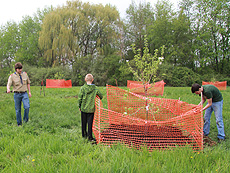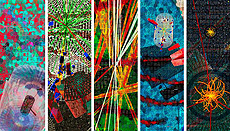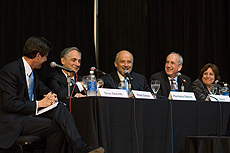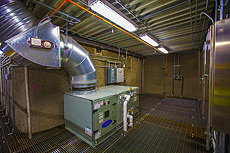|
Have a safe day!
Tuesday, May 21
10:30 a.m.
Research Techniques Seminar - Curia II
Speaker: Alexander Bolozdynya, National Research Nuclear University, Moscow
Title: Development of RED100 Liquid Xenon Emission Detector for Observation of Coherent Neutrino Scattering
3:30 p.m.
DIRECTOR'S COFFEE BREAK - 2nd Flr X-Over
4 p.m.
Accelerator Physics and Technology Seminar (NOTE LOCATION) - Curia II
Speaker: Rami Kishek, University of Maryland
Title: Overview of the University of Maryland Electron Ring Program
Wednesday, May 22
3:30 p.m.
DIRECTOR'S COFFEE BREAK - 2nd Flr X-Over
4 p.m.
Fermilab Colloquium - One West
Speaker: Naomi Makins, University of Illinois, Urbana-Champaign
Title: Spin at Fermilab and the Quest for L
Click here for NALCAL,
a weekly calendar with links to additional information.
Ongoing and upcoming conferences at Fermilab
|
|
Tuesday, May 21
- Breakfast: All-American breakfast
- Breakfast: bacon, egg and cheese bagel
- Twin chili cheese dogs
- Smart cuisine: Mediterranean baked tilapia
- Cuban steak with black-bean salsa
- Rachel melt
- Chicken BLT ranch salad
- Chef's choice soup
- Hungarian pork goulash
Wilson Hall Cafe menu
|
|
Wednesday, May 22
Lunch
- Salad nicoise
- Frozen blackberry chiffon pie
Friday, May 24
Dinner
- Beef en croute with coriander walnut filling
- Fennel and potato gratin
- Haricots verts with red peppers and almonds
- Coffee creme brulee
Chez Leon menu
Call x3524 to make your reservation.
|
|
LBNE informational meetings set for Thursday
Employees, users, neighbors and others who want to find out more about the proposed Long-Baseline Neutrino Experiment will have a chance to do so this Thursday, May 23.
Fermilab and the Department of Energy will host two meetings that day in the Wilson Hall atrium. From 11:30 a.m. to 1 p.m., employees, users and others at the laboratory will have a chance to view posters and mingle with LBNE scientists and engineers to obtain answers to their questions about the project. A brief presentation on the project and plans for the ongoing environmental assessment will be held in One West at noon.
An informational meeting for the public will be held in the Wilson Hall atrium from 6:30 to 8:30 p.m. This meeting will feature the posters and talks presented during the noon meeting.
The LBNE collaboration is developing plans to build four buildings on the Fermilab site, one located near Kirk and Giese roads. That building would be connected to an underground hall about 200 feet below the Fermilab site. LBNE would also require the construction of a 52-foot-high hill as part of the facility that would create the neutrinos for the experiment. In accordance with the National Environmental Policy Act, the environmental assessment investigates the potential impacts of the project on human health and the environment.
|
Planting apple trees
 |
In coordination with Ryan Campbell, FESS, Boy Scout Eagle Troop 9 of Downers Grove recently planted 12 apple trees in the Fermilab Village. Photos: Chris Jensen, AD |
|
A banner day at the LHC
 |
An artist honors the people and science of the CMS collaboration. Image courtesy of Xavier Cortada
|
There's a new splash of color at Point Five, the home of CMS detector on the Large Hadron Collider. Five vivid banners drape the gray walls of the complex, lending the warehouse a cathedral-like atmosphere. Arranged in a line, they pull the viewer's gaze from panel to panel to land on a true-to-scale photo of the detector itself, magnificently displayed on the back wall.
Art and science are both professions that move humanity forward, says the artist, Xavier Cortada from Florida International University of Architecture. He dreamed up the banner design with help from CMS physicist Pete Markowitz.
Read more
—Kelly Izlar
|
Huge magnet set for delicate voyage to Fermilab
From the Chicago Tribune, May 19, 2013
A 50-foot-wide circular electromagnet—so delicate that tilting it just a few degrees would destroy it—must make a four-week journey this summer off the U.S. coast and up a river, before inching its way by road to a new home at Fermilab in Batavia.
The Muon g-2 ring, an electromagnet made of steel and aluminum, begins its 3,200-mile trek from New York in early June. From there, it will sail by barge down the East Coast, around Florida's tip into the Gulf of Mexico, then up the Mississippi River until it arrives in Illinois.
Read more |
The world's rarest element might help fight cancer
From Motherboard, May 14, 2013
Never heard of astatine? You're not alone—it's the rarest naturally-occurring element on Earth. In fact, if you want to go find some astatine, have a blast: It's been estimated that, at most, there's just a couple grams of the stuff in all of the Earth's crust at any one time, formed from the natural decay of elements such as uranium. But rare as it is, new research from the folks at CERN suggests it could be used in a novel cancer therapy.
Read more |
|
Big Science: Big Challenges
 |
Director Oddone participated in a recent panel discussion titled "Big Science: Big Challenges" at the Museum of Science and Industry. From left: Steve Edwards, Robert Zimmer, Pier Oddone, Eric Isaacs, Trudy Vincent. Photo: Fermilab
|
On Thursday evening, the seventh in the series of joint events organized by the University of Chicago, Argonne and Fermilab took place at the Museum of Science and Industry in Chicago. The event brought together scientists, engineers and faculty members of the three institutions. The venue was the museum rotunda, a spectacular setting for an event on big science. After a short introductory video, 300 attendees listened to a vibrant discussion on "Big Science: Big Challenges," followed by many questions from the audience. The moderator, Steve Edwards, who is an experienced journalist, well-known radio host and the current deputy director of the Institute of Politics of the University of Chicago, did a great job moderating the discussion. In addition to myself, the panel included University of Chicago President Bob Zimmer, Argonne Director Eric Isaacs and University Associate VP for Government Relations Trudy Vincent. Each of us brought to the discussion our own individual perspectives on big science and on the current challenges to carry it out.
While there are common characteristics to projects we designate as big science, those projects are diverse. The extreme exponent of big science is the LHC and its major detectors. A project such as CMS, on which we work at Fermilab, brings together thousands of scientists from 140 institutions around the world to work together as a single team on its design, construction, data analysis and physics discoveries. The Human Genome Project also brought together several countries and institutions to produce a common information infrastructure that was then made public and is used by a wide spectrum of groups and individuals. As we push to higher energies in particle physics, to higher intensities in synchrotron light sources, or to larger and more complex data sets in modern biology, the tools we use will require the aggregation of resources on a very large scale. This shared characteristic of big science is what makes it difficult to fund, especially in times of limited resources. While there are many pieces to getting a project funded, one essential element is widespread support.
In discussing how to motivate the public, the White House and Congress to support and fund science—especially big science—President Zimmer reminded the audience that the function of government, as established in the U.S. Constitution, is not to fund science or big science but "to form a more perfect Union, establish Justice, insure domestic Tranquility, provide for the common defence, promote the general Welfare, and secure the Blessings of Liberty to ourselves and our Posterity." He then argued that if government is to fund big science, we need to explain the science we want to do not in the narrow context of our fields but in the broader context, established by the Constitution, of the functions of government, including contributing to the nation's general welfare and to a more perfect Union—undoubtedly, important advice for us all.
A link to the video of the full panel discussion will appear in Fermilab Today when available.
|
NOvA cavern electronics alcove nearly complete
 |
Almost there: Civil construction of the NOvA near-detector hall is nearly finished. Photo: Cindy Arnold
|
The NOvA electronics alcove is eagerly awaiting delivery of NOvA detector readout racks once construction is complete.
|
|